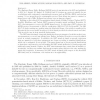Free Online Productivity Tools
i2Speak
i2Symbol
i2OCR
iTex2Img
iWeb2Print
iWeb2Shot
i2Type
iPdf2Split
iPdf2Merge
i2Bopomofo
i2Arabic
i2Style
i2Image
i2PDF
iLatex2Rtf
Sci2ools
CORR
2016
Springer
2016
Springer
Defeating the Ben-Zvi, Blackburn, and Tsaban Attack on the Algebraic Eraser
The Algebraic Eraser Diffie–Hellman (AEDH) protocol was introduced in 2005 and published in 2006 by I. Anshel, M. Anshel, D. Goldfeld, and S. Lemieux as a protocol suitable for use on platforms with constrained computational resources, such as FPGAs, ASICs, and wireless sensors. It is a group-theoretic cryptographic protocol that allows two users to construct a shared secret via a Diffie–Hellman-type scheme over an insecure channel. Building on the refuted 2012 permutation-based attack of Kalka–Teichner–Tsaban (KKT), Ben-Zvi, Blackburn, and Tsaban (BBT) present a heuristic attack, published November 13, 2015, that attempts to recover the AEDH shared secret. In their paper BBT reference the AEDH protocol as presented to ISO for certification (ISO 29167-20) by SecureRF. The ISO 29167-20 draft contains two profiles using the Algebraic Eraser. One profile is unaffected by this attack; the second profile is subject to their attack provided the attack runs in real time. This is...
| Added | 31 Mar 2016 |
| Updated | 31 Mar 2016 |
| Type | Journal |
| Year | 2016 |
| Where | CORR |
| Authors | Iris Anshel, Derek Atkins, Dorian Goldfeld, Paul E. Gunnells |
Comments (0)

